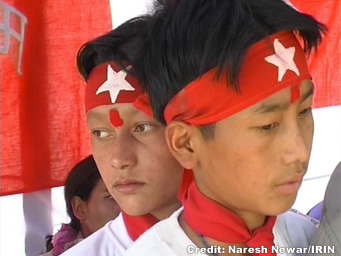 |
| Child Soldiers in Nepal |
|
|
|
|
|
|
|
|
|
|
| Challenges of reintegrating former child soldiers |
GULERIYA, 31 December 2007 (IRIN)
Thousands of former child soldiers have returned to their communities in Nepal over the past year, but there are huge challenges facing their successful reintegration, local non-governmental organisations (NGOs) say.
"We still have to work a lot at the community level to ensure that the former children associated with armed forces and groups (CAAFAGs) are treated like children, encouraged to rejoin school and not looked upon as a burden on society," said Iswari Prasad Biswokarma of the Dalit Welfare Organisation (DWO).
 |
|
Aged 9-18, these children initially joined the former Maoist rebels as entertainers and political workers but later ended up in the Maoist People's Liberation Army (PLA), NGO activists say.
Many were tortured to force them to collaborate with government forces, according to the CAAFAG working group
Fear
"Even today, many children still fear the return of war and constantly fear being tortured and abducted by both the Maoist rebels and government forces," said a reintegration worker in the remote Shivapur village, 30km from Guleriya, requesting anonymity.
"I'm not sure if my community will easily accept us back because they still hate the Maoists a lot," said a 15-year old schoolgirl who had been involved in the Maoists' cultural programmes.
Requesting anonymity, the young girl told IRIN in her Bagna village that many of her friends were still with the Maoists and had been sheltered in the UN-supervised Maoist cantonment site of Bardiya.
Effective reintegration programmes needed
Activists working with CAAFAGs say more needs to be done to promote their return: "Reintegration programmes should include more educational and vocational training as well as psycho-social support. This could help more CAAFAGs to return home," said CAAFAG worker Tilak Bahadur Sunuwar from DWO.
DWO, with help from agencies like International Rescue Committee (IRC), the UN Children's Fund (UNICEF) and Save the Children-Norway (SCF-N) have successfully reintegrated 147 CAAFAGs.
"The most important role is played by the local communities, but they need to be more aware of the need to help former CAAFAGs re-enrol in schools, learn vocational skills and assure them of a better future," said Biswokarma.
| Credit
IRIN 2008 Copyright © UN Office for the Coordination of Humanitarian Affairs 2008 [ This report does not necessarily reflect the views of the United Nations] Integrated Regional Information Networks (IRIN), part of the UN Office for the Coordination of Humanitarian Affairs (OCHA). |
 |
|
|

